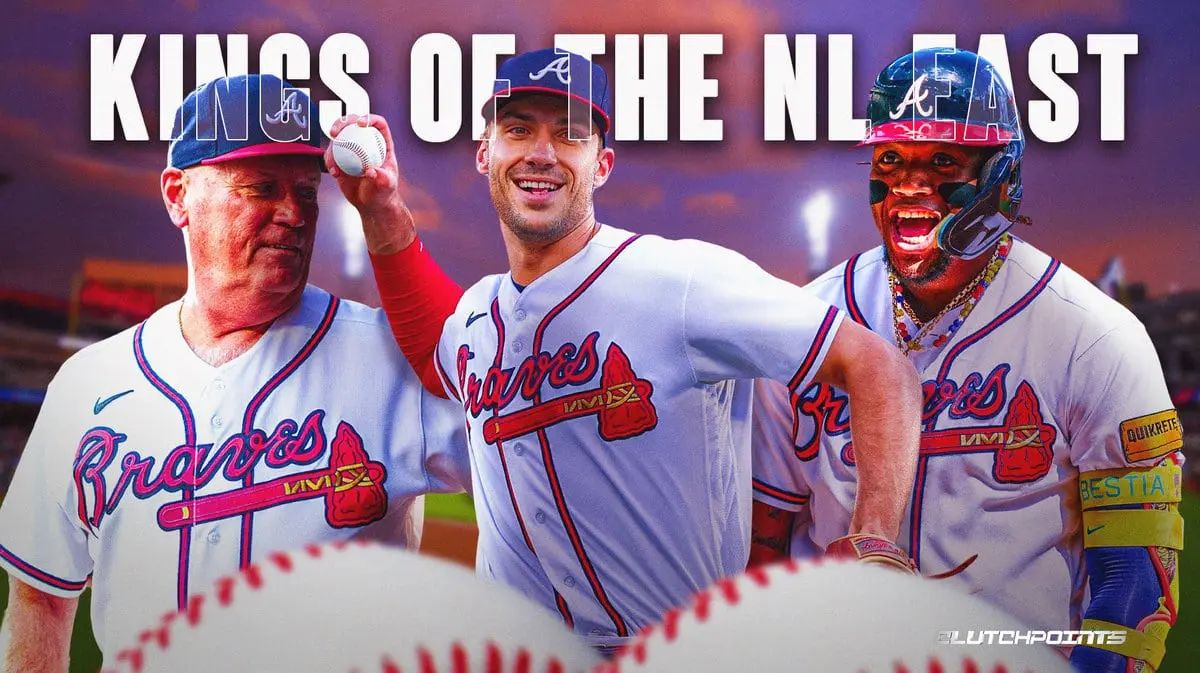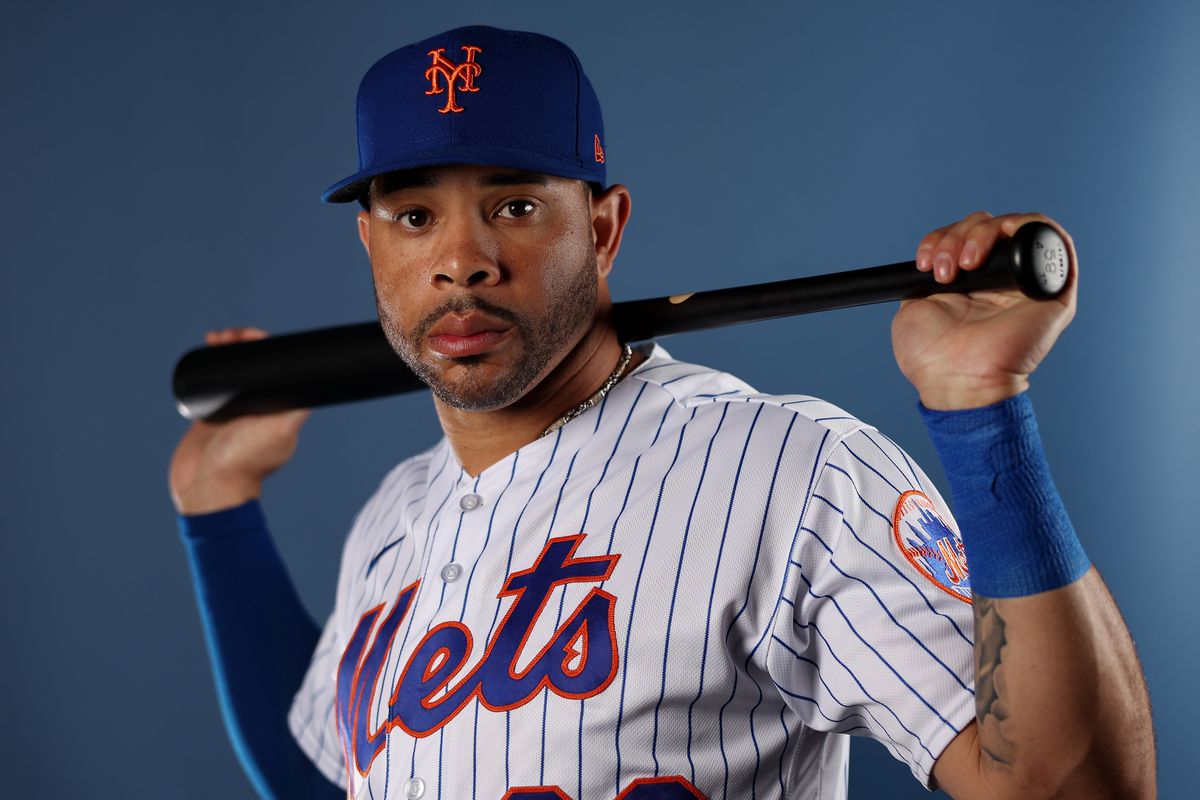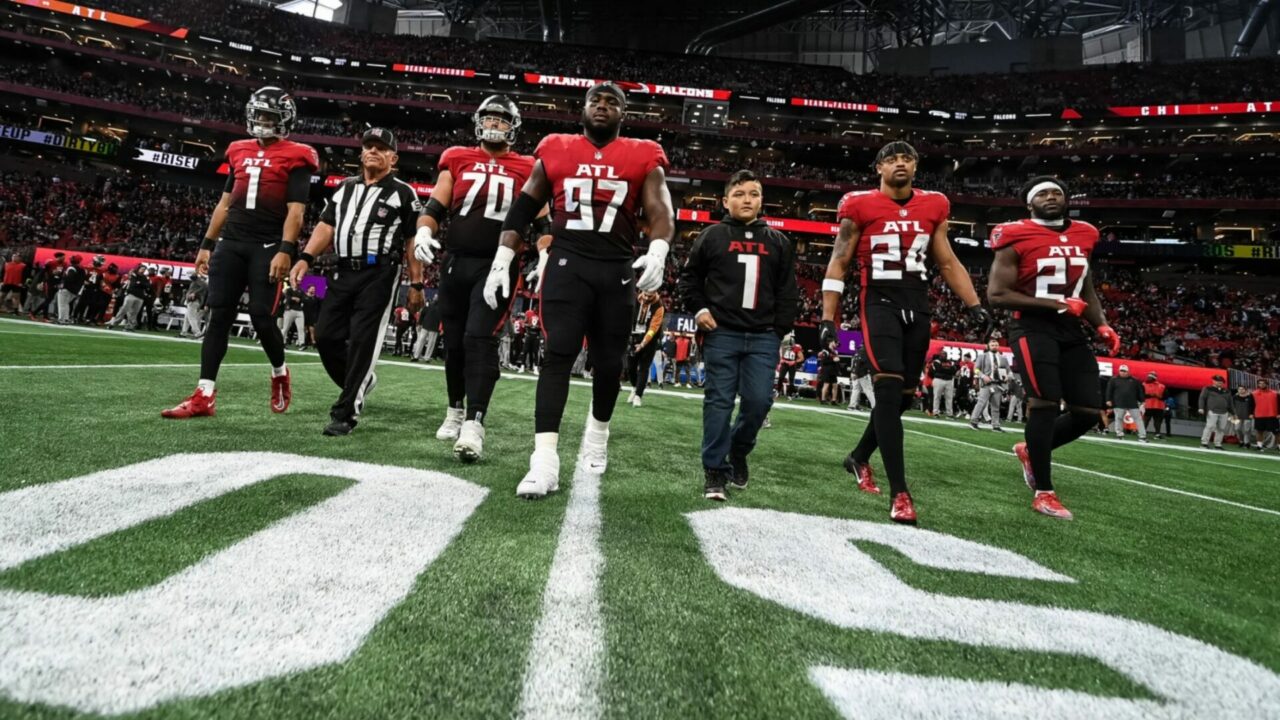They’re Not In The World Series, But Braves Were MLB’s Best
Orlando Arcia (11), Ozzie Albies, and Ronald Acuna Jr. of the Atlanta Braves celebrate… [+]
THE ASSOCIATED PRESS 2023 COPYRIGHT. ALL RIGHTS ARE RESERVED.
It’s time for my annual batted ball-based year-end team true-talent rankings – a quick refresher on the process is provided below.
In a nutshell, league averages for each exit speed/launch angle “bucket” are applied to each team’s batted ball population, both for and against, to calculate the production they “should have” attained and allowed. When the Ks and BBs are subtracted, each team earns an offensive and pitching rating in relation to the league average of 100. The higher the number, the better for batters; the lower the number, the better for pitchers.
Team defense is also measured in an unusual way. The performance of each club is compared head-to-head against the performance of their opponent; the ratio of actual production vs anticipated performance for both clubs is compared to each other, resulting in an overall defensive multiplier that can also be dispersed across the individual batted ball types.
I added a fresh twist in 2020. I implemented a team extreme ground ball-pulling punishment, identical to what I do with individual hitters. It has no effect on the total team rating, but it penalizes a club’s offensive rather than its defense for deficiencies in this area.
To qualify for such a penalty, a team had to both A) pull more than 5 times as many grounders as it hit to the opposite field, and B) post actual grounder production lower than the level it “should have” posted based on its exit speed. The penalty is equal to the amount of that difference. Three clubs were subjected to this penalty, same as in 2022, and down from 2021 (six) and 2020 (seven).
Yesterday we looked at the bottom 15 clubs; today we’ll look at the top 15. One club won 16 games more than they “should have,” the largest single discrepancy since I began using this system. 11 of the 12 postseason teams are represented (the Diamondbacks are placed 20th). The teams ranked 7, 8, and 12 on this list did not make the playoffs. The vast majority of people saw their projection closely match their actual record. So here we go:
Meet the Billionaire Owners Competing in the World Series
Manfred’s MLB Agenda: New Stadiums, Expansion, and the End of the AL-NL Season
When the Yankees win something, they reclaim half of the MLB True Talent Team Rankings.
Miami Marlins (current record 84-78, projected record 82-80)
Pitching Rating = 92.3 (7th), Defensive Rating = 101.9 (21st); 2023 All-Star Break = 12th
The pitching of the Marlins was clearly the finest of any team covered thus far. The Marlins struck out 203 fewer times than their opponents, which was offset only slightly by a -84 walk difference. They were the only club to have a single-digit average launch angle (9.7 degrees) on offense. They did put 256 more balls in play than their opponents, but their advantage in fly balls was only +28. They struck their batted balls just as hard as their opponents (average exit speed of 88.3 mph).
14. Boston Red Sox (Actual Record = 78-84, Projected Record = 85-77)
Offensive Rating = 103.1 (10th), Pitching Rating = 98.4 (13th), Defensive Rating = 99.9 (17th); 2023 All-Star Break = 7th
Like the Angels (11th to 22nd) the Red Sox capsized in the second half. This was actually one of the most average teams out there, hitting the ball almost exactly as hard as their opponents (88.8 to 88.6 mph), at almost the same exact launch angle (12.1 to 11.9 degrees), with very comparable team K and BB totals. The biggest positive difference? They hit 89 more fly balls than their opponents, not an insignificant factor in fly ball-friendly Fenway Park. They out-doubled their opponents by 23, but were out-homered by 26.
13. Baltimore Orioles (Actual Record = 101-61, Projected Record = 85-77)
Offensive Rating = 101.2 (13th), Pitching Rating = 100.9 (18th), Defensive Rating = 94.9 (4th); 2023 All-Star Break = 16th
The O’s won 16 more games than the underlying batted ball data says they should have. That’s not as crazy as you might think. This club was good, but not 101 wins good. They won a ton of close games, and their bullpen was instrumental in them doing so. Think of them as the anti-Padres, who have yet to heard from on this list. They were only +6 in homers, had similar K and BB totals as their opponents, and barely hit the ball harder than them (89.0 to 88.8 mph average exit speed). Their positive +2.3 degree launch angle advantage was their primary batted ball strength. Their infield defense was scintillating – their 77.5 grounder multiplier, which was more of a team accomplishment than an individual event, led the majors.
12. Chicago Cubs (Actual Record = 83-79, Projected Record = 85-77)
Offensive Rating = 99.3 (16th), Pitching Rating = 98.8 (14th), Defensive Rating = 94.7 (3rd); 2023 All-Star Break = 15th
The Cubs won 18 fewer games than the Orioles and coughed their way out of the playoffs in the last week of the season. They are the 12th and final playoff club, according to this method. They hit the ball slightly harder (88.4 to 87.8 mph average exit speed) and higher (12.2 to 11.8 degrees) than their opponents, as did the Orioles. Their K/BB profile in comparison to their opponents also reminds me of the Orioles. Their final resemblance to Baltimore is superb team defense, as evidenced by their 88.6 grounder multiplier, which was fueled by outstanding work up the middle from Dansby Swanson and Nico Hoerner.
11. Houston Astros (Actual Record = 90-72, Projected Record = 89-73)
Offensive Rating = 109.8 (4th), Pitching Rating = 100.0 (16th), Defensive Rating = 99.7 (16th); 2023 All-Star Break = 13th
And here is the four-game gap between the good and solid teams. The Astros’ primary strengths have remained steady over time: they put the ball in play, particularly in the air. They struck out 219 less than their opponents while putting 344 more balls in play. And that edge is concentrated in the most crucial batted ball categories, with a +160 advantage in flies and a +113 advantage in liners. They need this since their opponents hit the ball significantly faster than they do (88.2 to 89.1 mph), and their long-held launch angle advantage has vanished this season (13.0 degrees for and against).
10. Toronto Blue Jays (Actual Record = 89-73, Projected Record = 90-72)
Offensive Rating = 104.8 (7th), Pitching Rating = 94.5 (11th), Defensive Rating = 98.7 (11th); 2023 All-Star Break = 5th
Pretty steep decline from 5th at the break, though that was more other teams moving up than the Jays moving down. Weird club whose strengths and weaknesses shifted this season. They no longer crush the baseball – their opponents had slight exit speed (88.2 vs. 88.4 mph) and launch angle (12.8 to 13.1 degrees) advantages, and the Jays had a -10 homer differential. On the other hand, they struck out 225 fewer and walked 62 more times than their opponents, putting 275 more balls in play. The old Jays had a lower floor and a higher upside, and I’d honestly like to see them return.
9. Milwaukee Brewers (Actual Record = 92-70, Projected Record = 91-71)
Offensive Rating = 93.1 (25th), Pitching Rating = 91.4 (5th), Defensive Rating = 89.9 (1st); 2023 All-Star Break = 19th
No team made a bigger second half move than the Brewers, driven by the dominance of Brandon Woodruff, whose absence was part of the reason they quickly disappeared in the playoffs. This is an incredibly one-dimensional run prevention-oriented outfit. Only the A’s hit fewer line drives, and they somehow won 92 games despite a -33 homer differential. Their opponents hit the ball harder (88.0 to 88.1 mph) and higher (11.4 to 12.3 degrees). On the other hand, they walked 98 more times than their opponents, and had by far the best team defense around. They were great everywhere, with 83.8 fly ball (led by Joey Wiemer) and 88.6 grounder (led by Willy Adames) multipliers.
8. San Diego Padres (Actual Record = 82-80, Projected Record = 92-70)
Offensive Rating = 107.8 (5th), Pitching Rating = 90.5 (4th), Defensive Rating = 103.2 (25th); 2023 All-Star Break = 10th
The 10-game difference between actual and predicted wins should come as no surprise given that these individuals outscored their opponents by more than a hundred runs. When their average offensive and pitching ranks are added together, the Padres have the lowest total at 9. That doesn’t make them the best club in baseball, but it does suggest they’re close. They walked 96 more batters and struck out 134 fewer times than their opponents, while putting 154 more balls in play and had a +31 homer edge. They struck the ball far harder (88.6 to 87.5 mph) and higher (12.8 to 11.3 degrees) than their opponents. The only significant flaw? Below-average team defense, with an MLB-worst fly ball multiplier of 122.8, owing entirely to Juan Soto’s performance.
7. Seattle Mariners (Actual Record = 88-74, Projected Record = 93-69)
Offensive Rating = 104.1 (9th), Pitching Rating = 91.6 (6th), Defensive Rating = 98.2 (10th); 2023 All-Star Break = 9th
The final and best non-playoff team in the top half of the standings. Throughout 2022, I remarked that the Mariners were ahead of plan – 2023 would be their breakout year. So, that should have been it. Weird offensive team that struck out a lot (144 more times than its opponents) while its pitchers didn’t walk anyone (127 fewer than Mariner hitters drew). They hit 130 fewer balls than their opponents, but they hit them far faster (89.1 to 88.4 mph) and much higher (15.0 to 12.2 degrees). Only the Dodgers had a higher offensive team launch angle, however the M’s proclivity to pop up played a role.
6. Texas Rangers (Actual Record = 90-72, Projected Record = 93-69)
Offensive Rating = 110.8 (3rd), Pitching Rating = 99.5 (15th), Defensive Rating = 95.4 (5th); 2023 All-Star Break = 2nd
The Rangers dropped from second place on this ranking during the All-Star break to 21st by the end of the 2022 season. Only the Braves hit the ball harder than these guys, and despite having a nearly average pitching staff, they had a +35 homer difference due to their offensive punch. Despite having only 113 more balls in play than their opponents, they enjoyed significant advantages in fly ball (+145) and line drive (+84). Another important strength was team defense, particularly in the outfield (88.0 fly ball multiplier), where Adolis Garcia and late-season newcomer Evan Carter excelled.
5. Philadelphia Phillies (Actual Record = 90-72, Projected Record = 94-68)
Offensive Rating = 101.5 (12th), Pitching Rating = 88.1 (2nd), Defensive Rating = 97.4 (8th); 2023 All-Star Break = 6th
This probably isn’t the way most view the Phillies – as a team with elite pitching, solid defense and slightly above average offense. But think about it – what other team gets as high a percentage of its total innings pitched from two elite starters? Their exit speed (88.9 to 87.8 mph) and launch angle (12.9 to 11.8 degrees) edges are rooted more in pitching than offensive strength, as is their +69 walk advantage. On the other hand, their +35 homer differential is driven by a +32 105+ mph fly ball advantage. Otherwise, they hit almost exactly as many flies as they allowed. Their positive team defensive performance is largely to a 96.2 grounder multiplier, with 2B Bryson Stott leading the way.
4. Minnesota Twins (Actual Record = 87-75, Projected Record = 95-67)
Offensive Rating = 104.6 (8th), Pitching Rating = 86.4 (1st), Defensive Rating = 101.2 (19th); 2023 All-Star Break = 8th
Here’s a bunch whose rating quietly spiked in the second half. Exactly one Twin – Carlos Correa – had enough plate appearances to qualify for the batting title, but almost all of them hit the ball hard. And on the mound they were exceptional. Their +151 walk advantage was driven mostly by the pitchers’ efforts, and was only partially offset by the hitters’ tendency to whiff (+94 K differential). Though no Twin hit more than 24 homers, they hit 233 as a team and had a +39 homer differential. Though their team exit speed differential was only +0.6 mph (88.9 to 88.3 mph), their fly ball authority advantage was much larger (1.8 mph, 92.3 to 90.5).
3. Tampa Bay Rays (Actual Record = 99-63, Projected Record = 96-66)
Offensive Rating = 100.0 (15th), Pitching Rating = 90.2 (3rd), Defensive Rating = 92.0 (2nd); 2023 All-Star Break = 3rd
A slightly better version of this year’s Phillies, according to this method, albeit with significantly better defense. The Rays were much better than their opponents when the ball wasn’t put in play, walking 75 more times and whiffing 87 less. They put 152 more balls in play than their opponents, but that advantage was concentrated in the correct category, with a +89 fly ball advantage. This, along with an authority advantage, allowed them to out-homer their opponents by 53. Defense was also a huge calling card, largely due to a 79.0 grounder multiplier, due largely to the efforts of SS Wander Franco, who remains on administrative leave.
2. Los Angeles Dodgers (Actual Record = 100-62, Projected Record = 99-63)
Offensive Rating = 112.6 (2nd), Pitching Rating = 93.0 (8th), Defensive Rating = 96.4 (7th); 2023 All-Star Break = 4th
During the postseason, the 20 Diamondbacks were at their best, while the Dodgers were at their worst, with a makeshift starting staff falling well short. This is our third and last squad to be penalized for excessive grounder-pulling. The Dodgers, with a +49 homer difference, are the most extreme lift-and-pull team in baseball, but they do so in a very subtle manner. Their 15.3 degree average launch angle was the highest in the game, but they hit 205 more fly balls while popping up one less time. In addition, they walked 190 more times than their opponents. Their overall offense was strong, topped by CF James Outman’s 84.6 fly ball multiplier.
1. Atlanta Braves (Actual Record = 104-58, Projected Record = 105-57)
Offensive Rating = 131.7 (1st), Pitching Rating = 93.5 (9th), Defensive Rating = 103.3 (26th); 2023 All-Star Break = 1st
This season’s top baseball squad by a significant margin. Their combination of brute attacking force and the ability to make consistent contact – characteristics demonstrated by presumptive MVP Ronald Acuna Jr. – was enough to win the game. Their offensive average exit speed of 90.9 mph was comfortably the greatest in baseball, as was their +2.4 exit speed differential. This despite striking out 227 less times than their opponents. It’s similar to a cheat code. They outshot their opponents by a whopping +120. That is not a typo. There’s even more in there. Their average launch angle was actually lower (by 11.9 to 12.5 degrees) than their opponents’. Weaknesses? Team defense, I suppose, especially in the outfield (106.1 fly ball difference), where Acuna struggled in particular.



